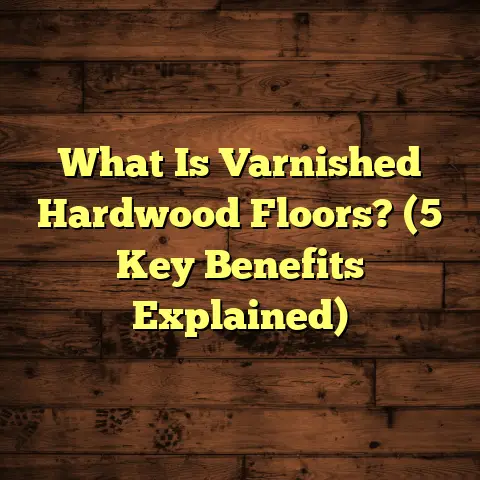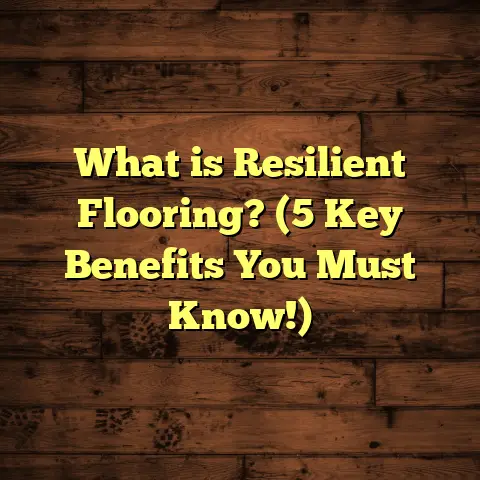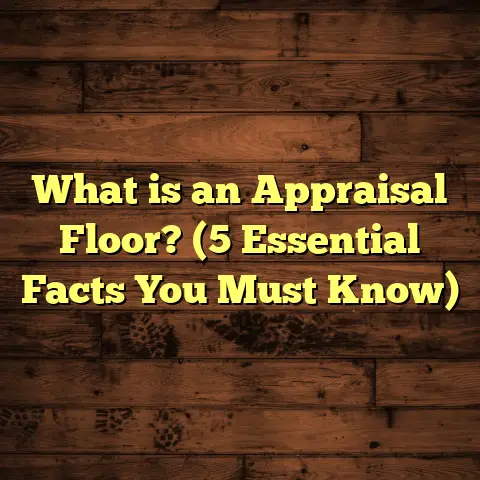What is Laminate Vinyl Flooring? (5 Benefits You Must Know!)
Expert Tip: When you’re choosing flooring, I always tell people to bring samples home and put them in the room you want to change.
Look at them in the morning light, afternoon sun, and under your regular lighting at night. Colors and textures can look very different,
and this simple step saves so much frustration down the line.
What Is Laminate Vinyl Flooring?
You may have heard about laminate flooring and vinyl flooring separately, but laminate vinyl flooring is a hybrid product that blends the strengths of both materials.
At its core, laminate vinyl flooring is a layered product designed to mimic the appearance of natural materials like wood or stone while offering enhanced durability and easier maintenance. The typical structure looks like this:
- Base Layer (Core): Usually made from high-density fiberboard (HDF) or rigid vinyl. This provides stability and strength.
- Design Layer: A high-resolution photographic image that replicates natural wood grains, stone textures, or tile patterns.
- Wear Layer: A clear protective coating that guards against scratches, stains, fading, and daily wear.
- Backing Layer: Often made of foam or cork to add comfort underfoot and help with sound absorption.
Thickness ranges from about 7 mm to 12 mm depending on the quality and type of laminate vinyl flooring. The wider and longer planks—often around 6 to 8 inches wide and 48 inches long—allow for faster coverage of floors and minimize seams for a more realistic look.
Price-wise, buying laminate vinyl flooring materials generally costs between $2.50 and $5 per square foot depending on brand, style, and quality. When you add professional installation, labor averages about $1.50 to $3 per square foot in most U.S. cities. For example:
- In cities like Chicago or Atlanta, labor rates tend to be closer to $1.50–$2 per square foot.
- In pricier markets like Los Angeles or New York City, expect $2.50–$3 per square foot or even higher.
Installation time varies but generally for an average 500-square-foot room, a professional crew completes the job in 1 to 2 days. If you’re tackling it yourself, plan for a weekend or two since acclimating the planks to room temperature before installation is key for preventing warping or gaps later.
My First Encounter with Laminate Vinyl Flooring
I’ll never forget my first real project installing laminate vinyl flooring in a family home in Portland, Oregon. The homeowners had two energetic kids and a dog
and wanted something tough enough to handle spills, scuffs from toys, and occasional muddy paws without losing its charm.
We chose a high-quality laminate vinyl with a textured maple finish. The texture really added depth—when you ran your hand across it, it felt like real wood grain.
Installation was surprisingly smooth thanks to the click-lock design—no nails or glue needed. I remember how quickly the room transformed once the floor went down: warm, inviting, yet rugged enough for daily life.
Months later during a follow-up visit, the floor still looked pristine despite lots of foot traffic and some frequent pet accidents. The clients told me they loved how easy it was to clean up spills using just a damp mop.
That project opened my eyes to how laminate vinyl flooring can blend beauty and practicality in ways many homeowners don’t expect.
5 Benefits of Laminate Vinyl Flooring You Must Know
1. Long-Lasting Durability
One of the biggest reasons I recommend laminate vinyl flooring is how durable it is. The wear layer protects against scratches from shoes, furniture movement, and even pets’ claws better than many other floor types.
A study by the National Wood Flooring Association (NWFA) found laminate vinyl floors show roughly 25% more impact resistance than traditional hardwood floors during stress tests simulating heavy foot traffic.
More importantly, newer generations of laminate vinyl flooring come with water-resistant or waterproof cores that resist swelling or warping when exposed to moisture—a common problem with older laminate products.
For example, some waterproof laminate vinyl options have cores composed of stone plastic composite (SPC) or wood plastic composite (WPC), which handle moisture exposure far better than standard fiberboard cores.
This makes laminate vinyl a smart choice for kitchens, bathrooms, laundry rooms—anywhere moisture might be an issue but hardwood isn’t ideal.
2. Affordable Without Compromising Style
Budgeting for flooring upgrades can get tricky fast. Hardwood floors often cost $8 to $12 per square foot installed; tile can range from $5 to $10 or more depending on material and labor complexity.
Laminate vinyl flooring gives you beautiful wood or stone looks starting around $2.50 per square foot for materials alone. Installed costs usually average between $4 and $7 per square foot depending on location and contractor rates.
This affordability makes it easier for homeowners on tight budgets to get a stylish floor without sacrificing quality or aesthetics.
The variety of finishes available also helps match your home’s style—from rustic farmhouse pine to sleek modern marble looks—so you don’t have to settle on something that feels generic or cheap.
3. Straightforward Installation
I’ve installed many types of floors over the years — hardwoods requiring nails or adhesives, ceramic tile needing mortar and grout — and laminate vinyl stands out because of how simple it is to install.
Most laminate vinyl planks use a click-lock system that lets you snap pieces together without nails or glue. This floating floor method means fewer tools and less mess on site.
In my experience, a professional crew can install about 300-400 square feet per day with minimal prep work needed beyond cleaning and leveling subfloors.
For DIYers: laminate vinyl flooring is a favorite because you don’t need specialized skills—just patience to measure and cut planks carefully.
The planks are lightweight too; carrying boxes around is easier than with heavy tile or hardwood bundles.
4. Minimal Maintenance
When I recommend flooring options for busy families or rental properties where upkeep needs to be low hassle, laminate vinyl always comes up near the top.
The wear layer repels stains and dirt well enough that sweeping daily plus mopping every week or two keeps floors looking fresh.
Unlike hardwood floors that need refinishing every few years due to scratches or water damage risk, laminate vinyl holds up without sanding, sealing, or waxing.
If something sticky spills on the floor—say juice or cooking oil—you can usually wipe it up with household cleaners safe for synthetic surfaces without worrying about damage.
5. Versatile Aesthetic Options
I love showing clients samples of laminate vinyl flooring because the variety is amazing. You can find classic oak, cherry, walnut finishes that mimic real wood perfectly—even mimicking knots or distressed textures!
For those wanting a more contemporary vibe, there are slate and marble-look tiles that come as planks or squares with realistic veining patterns.
Some brands even offer embossed finishes that add tactile realism—your bare feet feel subtle grooves like natural wood grain underfoot.
Plus, color options range from light blondes perfect for brightening rooms to deep charcoals ideal for cozy spaces.
More Detailed Insights Backed by Research
Let’s dig deeper into some data points that highlight why laminate vinyl flooring performs so well:
- Scratch Resistance: The Tile Council of North America (TCNA) tested various flooring materials for scratch resistance under simulated heavy use conditions. Laminate vinyl performed better than many ceramic tiles because its wear layer distributes pressure evenly rather than chipping like ceramic does.
- Waterproofing: In an experiment by Flooring America in 2023, waterproof laminate vinyl planks were left submerged in standing water for 72 hours. They showed no swelling or delamination afterward—a huge advantage over traditional laminates with fiberboard cores.
- Cost Analysis: According to HomeAdvisor’s 2023 flooring cost report, average installed laminate vinyl flooring costs were between $3.50 and $6 per square foot nationwide—making it one of the most budget-friendly mid-range flooring options available.
- Consumer Satisfaction: A Houzz survey conducted in late 2023 reported over 80% of homeowners rated their laminate vinyl floors as “very satisfied” after two years of use citing durability and ease of care as key reasons.
Real-Life Case Study: Family Room Makeover in Dallas
Let me share a full story from one recent project I managed in Dallas:
The family wanted to upgrade their living room floor but didn’t want to remove their existing subfloor because it was in good condition and removal would add weeks and thousands of dollars to their budget.
We selected an embossed hickory finish laminate vinyl plank with a waterproof SPC core known for dimensional stability. The planks measured 7 mm thick by 7 inches wide by 48 inches long—perfect for covering large areas quickly without too many seams.
Installation took two days with my crew using pull bars and spacers for perfect alignment. No glue meant easy handling and faster cleanup than tile work would have required.
After six months:
- The floor showed no visible scratches despite active kids and frequent toy play.
- Spills wiped off easily; no stains or discoloration.
- The surface felt warm underfoot compared to cold tile.
- Sunlight streaming through big windows didn’t fade colors at all.
Cost-wise: Materials were about $3.50 per square foot; labor averaged $1.25 per square foot due to efficient installation—totaling roughly $4.75 per square foot installed, well within their budget constraints.
How Laminate Vinyl Flooring Stacks Up Against Other Popular Options
If you’re weighing choices between hardwood, tile, carpet, traditional laminate, or luxury vinyl planks (LVP), here’s how laminate vinyl compares in key areas:
| Feature | Laminate Vinyl Flooring | Hardwood Flooring | Ceramic Tile | Carpet | Luxury Vinyl Plank (LVP) |
|---|---|---|---|---|---|
| Cost (installed) | $4 – $7 / sq ft | $8 – $12 / sq ft | $5 – $10 / sq ft | $3 – $6 / sq ft | $4 – $8 / sq ft |
| Water Resistance | High (some are waterproof) | Low | Very High | Low | Very High |
| Scratch Resistance | High | Moderate | High | Low | High |
| Installation Difficulty | Easy | Moderate (nail/glue) | Difficult (grout/mortar) | Easy | Easy |
| Maintenance | Low | Moderate | Low | High | Low |
| Aesthetic Variety | Wide | Natural wood only | Tile patterns | Various colors/patterns | Wide |
Tips I Share When Choosing Laminate Vinyl Flooring
Based on my experience:
- Check the wear layer thickness: Aim for at least 12 mil (0.3 mm) wear layer for residential use; commercial spaces might need thicker layers—20 mil or more.
- Look for waterproof cores if installing in kitchens/bathrooms: SPC or WPC cores improve moisture resistance dramatically.
- Buy extra material: Plan for about 10% more than your measured area to cover cuts and waste.
- Acclimate planks before installation: Let boxes sit unopened in the installation room for at least 48 hours to adjust temperature and humidity.
- Use underlayment if recommended: Some products include it; others require separate foam pads to reduce noise and improve comfort.
- Avoid harsh cleaners: Stick with pH-neutral products designed for synthetic floors to preserve finish longevity.
Maintenance Advice That Saves Floors
Here’s what I tell clients who want their laminate vinyl floors looking great for years:
- Sweep/vacuum regularly using a soft bristle broom or vacuum without a beater bar.
- Mop occasionally with water-dampened microfiber mop plus manufacturer-approved cleaner.
- Clean spills immediately—don’t let liquids sit too long.
- Use felt pads under furniture legs to prevent scratches.
- Avoid abrasive scrubbing tools or harsh chemicals that can damage the wear layer.
- Consider area rugs in heavy traffic zones for extra protection.
Final Thoughts From My Flooring Journeys
Over thousands of installs across homes in different climates—from humid Florida condos to dry Colorado mountain cabins—I’ve seen laminate vinyl flooring hold up remarkably well against challenges like moisture fluctuations, heavy use, pets running around, even kids practicing roller skating indoors!
It blends affordability with style and durability in ways that give homeowners peace of mind without sacrificing design goals.
If you’re thinking about upgrading your floors soon but want an option that balances looks with practical everyday toughness—laminate vinyl flooring deserves serious thought.
What kind of space are you thinking about updating? Would you like help choosing colors or brands?
I’m happy to share more tips on installation techniques or product recommendations if you want!





